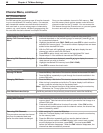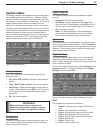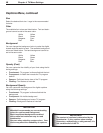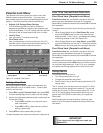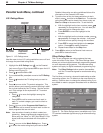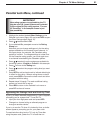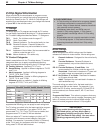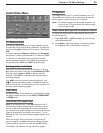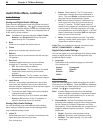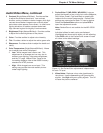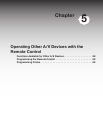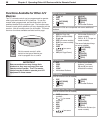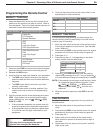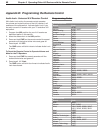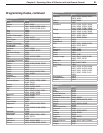
54 Chapter 4. TV Menu Settings
Audio/Video Menu, continued
Audio Settings
Analog and Digital Audio Settings
Enter the audio adjustment mode using either the Audio/
Video menu or the
AUDIO
key. Use to change settings.
The adjustable settings display a slider and corresponding
numeric value on screen. Values can be adjusted from 0
to 63, with 31 as the midpoint.
Note: The effects of the audio settings of Bass, Treble,
Balance, and Surround affect only the sound
heard through the TV speakers.
◊ Bass
Enhances or reduces low-pitched sound.
◊ Treble
Enhances or reduces high-pitched sound.
◊ Balance
Adjusts the level of sound between the left and right
TV speakers.
◊ Surround
Creates simulated stereo and surround effects
through the TV speakers. Your choices are:
• Off: No surround effects (default).
• Simulated Stereo: The TV creates a simulated
stereo effect when watching a non-stereo
program.
• Surround Sound: The TV creates a simulated
surround effect when watching a stereo program.
◊ Level Sound
When on, automatically equalizes the volume level
when there are significant sound-level differences
between program segments, such as between regular
programming and commercials.
• To receive the best fidelity with music programs,
change this setting to Off.
• When connecting to an A/V receiver, set Level
Sound to Off and turn off the TV speakers to
send full dynamics to the A/V receiver.
Analog-Only Audio Settings
You can set analog-only audio settings while viewing
either analog or digital sources, but the settings affect
only broadcast analog content.
◊ Listen To
Determines how your TV receives a broadcast audio
signal and plays the sound you hear.
Your choices are:
• Stereo: Default setting. The TV plays stereo
broadcasts in stereo and mono broadcasts in
mono. The word Stereo is displayed when you
tune to a channel broadcasting in stereo.
• SAP (Second Audio Program): Additional mon-
aural sound track that you cannot hear during
normal TV viewing. The SAP signal might be
related to the program you are watching, (such as
a sound track in a foreign language), or it might
be unrelated (such as a weather report). If an SAP
signal is broadcast, the letters SAP are displayed
when you tune to the channel.
• Mono: Reduces background noise. Use when
receiving a weak stereo audio signal. All audio is
played mono with this setting.
Listen To is not available for devices connected to the
INPUT,
COMPONENT
or
HDMI
jacks.
Digital-Only Audio Settings
You can set digital-only audio settings while viewing either
analog or digital sources, but the settings affect only
broadcast digital content.
◊ Language
Determines what possible language you can hear.
Your choices are:
English Portuguese
French Spanish
German Other
Italian
Video Settings
Enter the video adjustment mode using either the Audio/
Video menu or the
VIDEO
key. Press the
VIDEO
key repeatedly
to cycle through the video options to the one you want to
change. Use to change settings.
Note: A slider displays on screen for some settings.
When the slider is displayed, it represents numeric
values, with 63 as the maximum, 31 as the mid-
point, and 0 as the minimum.
◊ Picture Mode: Set the Picture Mode first before
adjusting other settings, as each Picture Mode stores
its own values for Contrast, Brightness, and Color
Temperature. Picture Modes allow you to optimize the
image for different lighting conditions. The Picture
Modes are:
• Bright: Suited for most daytime viewing.
• Natural: Suited for most nighttime viewing.
• Brilliant: The default setting. For use under
strong light.



